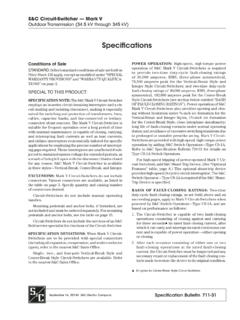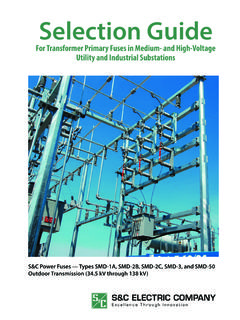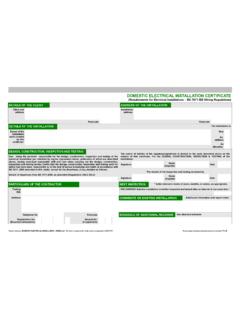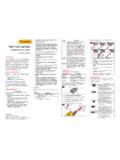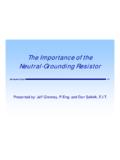Transcription of SELECTION GUIDE FOR TRANSFORMER-PRIMARY …
1 DATA BULLETIN240-110 Page 1 of 78 August 6, 1984S&C ELECTRIC COMPANY ChicagoS&C ELECTRIC CANADA LTD. RexdaleSupersedes Data Bulletin 240-110 dated 4-12-82 1984 Price $ GUIDE FOR TRANSFORMER-PRIMARY FUSES IN MEDIUM-VOLTAGE INDUSTRIAL, COMMERCIAL, AND INSTITUTIONAL POWER SYSTEMSS&C Power Fuses Types SM, SML, and SMD-20 Indoor and Outdoor Distribution ( kv through kv)S8C Power Fuses - Types SM, SML, and SMD-20 Indoor and Outdoor Distribution ( kv through kv) I TABLE OF CONTENTS I Section Page Number GENERAL .. 2 APPLICATION PRINCIPLES Select the Primary Fuse Rating .. 5 Accommodate Expected Loading Levels.. 6 Withstand Inrush Currents .. Protect Transformer Against Damaging .. Coordinate with Other protective Devices .. 16 Protect Downstream Conductors Against Damaging Overcurrents .. 27 THE FUSE SELECTION TABLES Introduction to Fuse SELECTION Tables.
2 29 Basis for Listings in the Fuse SELECTION Tables .. 31 .. 37 Fuse SELECTION Tables .. How to Use the Fuse SELECTION Tables .. I GENERAL 1 This data bulletin is a GUIDE for the SELECTION , applica- tion, and coordination of S&C Power Fuses-Types SM, SML, and SMD-20 when applied on the primary side of medium-voltage transformers in industrial, commer- cial, and institutional power systems. The information and recommendations presented in this publication apply regardless of whether the fuses are connected directly to the transformer primary or are remotely con- nected through insulated cable or enclosed bus duct. For the purpose of this GUIDE , medium-voltage transformers are those having primary voltage ratings between kv and kv, with either low-voltage (208 v, 240 v, 480 v, or 600 v) or medium-voltage ( kv or kv) secondaries. The function of a transformer primary-side protective device is, in general, to provide system protection as well as transformer protection.
3 With respect to system protection, a primary-side protective device should detect a potentially damaging overcurrent condition and operate promptly to isolate only the faulted seg- ment, thereby minimizing the short-circuit stresses on the remainder of the system and limiting the extent of the service interruption to only the affected segment. For transformer protection, a primary-side protective device should operate promptly in response to a bus or cable fault located between the transformer and the nearest secondary-side overcurrent protective device. It should further provide backup protection for the trans- former in the event the secondary-side overcurrent pro- tective device either fails to operate due to a malfunc- tion, or operates too slowly due to incorrect (higher) ratings or settings. To best achieve these objectives, group protection of transformers is not generally recom- -A 2404 10 DATA BULLETIN Page 2 of 78 August 6,1984 S&C ELECTRIC COMPANY.
4 Chicago S&C ELECTRIC CANAOA LTO - Rexdale SELECTION GUIDE for TRANSFORMER-PRIMARY Fuses in Medium-Voltage I Industrial, Commercial, and Institutional Power Systems I GENERAL mended-each transformer should be individually pro- tected. The ampere rating of a primary-side protective device selected to accommodate the total loading requirements of two or more transformers would typi- cally be so large that only a small degree of secondary- fault protection-and almost no backup protection- would be provided for each individual transformer. Moreover, for group-protection situations involving transformers of unequal sizes, the ampere rating of the primary-side protective device might even be greater than the already large maximum ampere rating permit- ted by the National Electrical Code for the smallest transformer. In addition, with group protection of trans- formers, the degree of service continuity is significantly reduced, since a fault associated with any one trans- former protected by a given device will result in the loss of service to all transformers protected by the device.
5 A variety of primary-side protective devices such as cir- cuit breakers, solid-material power fuses, and current- limiting fuses are available to accomplish the above tasks. In industrial, commercial, and institutional power systems, circuit breakers have been used for applica- tions requiring complex relaying schemes or high con- tinuous currents. However, for most applications a choice of either circuit breakers or power fuses is avail- able. Fuses have achieved widespread use in most such applications because of their simplicity, economy, fast response characteristics, and freedom from maintenance. Circuit breakers and their associated relays are com- monly used where the reclosing capability of the circuit breaker is an advantage, such as applications involving overhead lines which have a relatively high incidence of transient or temporary faults.
6 This reclosing feature is neither useful nor desirable in industrial, commercial, and institutional power systems where the conductors are arranged in cable trays or enclosed in conduit or bus duct. The incidence of faults on these systems is low, and the rare faults that do occur are not transient and result in significant damage that would only be exacer- bated by an automatic reclosing operation. The relaying associated with circuit breakers is avail- able in varying degrees of sophistication and complex- ity. Systems requiring differential protection, reverse- power relaying, or non-current-magnitude tripping of the protective device typically require circuit breakers. However, the sizes of transformers normally associated with industrial, commercial, and institutional power systems generally do not warrant such sophisticated protection.
7 Indeed, many users find that the complexity of such protective relaying, with its requirement for periodic testing and recalibration, is a distinct disadvantage. Circuit breakers are also used in applications requir- ing a very high-above 720 amperes-continuous cur- rent-carrying capability. While this may be an advan- tage in some cases, a higher degree of service continuity can be achieved with less expensive power fuses by subdividing the system into a larger number of discrete segments, with the result that a fault on one segment of the system affects fewer loads. This high degree of seg- mentation also allows the use of smaller transformers located strategically throughout the system, eliminat- ing the need for the unnecessarily long, high-ampacity secondary conductors that are required where fewer, larger, widely separated transformers are used.
8 Where high continuous current-carrying capability is not required and where reclosing or sophisticated relay- ing is not justified-as is the case in the majority of transformer protection applications in medium-voltage industrial, commercial, and institutional power systems-power fuses offer a number of advantages. Power fuses are simple to install and require no mainte- nance of any kind-even after years of inattention, power fuses will operate properly. Recalibration is neither required nor possible. Hence, elaborate testing procedures are not needed, eliminating the possibility that a carefully engineered coordination plan will acci- dentally be disturbed. Power fuses, unlike circuit break- ers, provide fault protection for the system without dependence on a source of control power, such as stor- age batteries and their chargers. Such batteries may be found completely discharged and thus incapable of tripping the circuit breaker should a fault occur.
9 In addi- tion, for high-magnitude faults, power fuses have inher- ently faster response characteristics than circuit break- ers, permitting more rapid removal of faults from the system with these advantages: 1. The duration of the voltage dip associated with the fault is reduced significantly, minimizing the poten- tial for disruption of the remaining loads; 2. The duration of stresses on motors in other segments of the system is shortened; 3. The conductor temperature rise due to the fault cur- rent is lessened, permitting the use of conductors one or more sizes smaller than those required by slower operating circuit breakers, resulting in considerable savings; and DATA BULLETIN 2404 10 S&C ELECTRIC COMPANY- Chicago Page 3 of 78 S&C ELECTRIC CANADA LTO Rexdale August 6,1984 SBC Power Fuses - Types SM, SML, and SMD-PO Indoor and Outdoor Distribution ( kv through kv) 1 GENERAL 4.
10 The upstream protective device can be set to operate faster-for better protection-while still coordinat- ing with the TRANSFORMER-PRIMARY fuse. Thermal damage to three-phase motors due to single- phasing-once thought to be a problem associated with the use of power fuses on the primary side of a trans- former-is of no concern, since the National Electrical Code requires that motors be equipped with an overcur- rent protective device in each of the threesupply phases. In addition, devices are now widely available which detect open-phase conditions caused by blown fuses and such other events as utility-line burndown, broken con- ductors, single-phase switching, or equipment malfunc- tions, and which initiate a switching operation to iso- late the load or transfer to an alternate source. Further- more, power fuses provide selective isolation of only faulted phases of three-phase feeders serving single- phase loads, unlike the undiscriminating operation of circuit breakers which remove all three phases from the system-even on single-phase faults.
